深圳朗文英语六年级上册各单元重要知识点
六年级朗文阅读英语上册
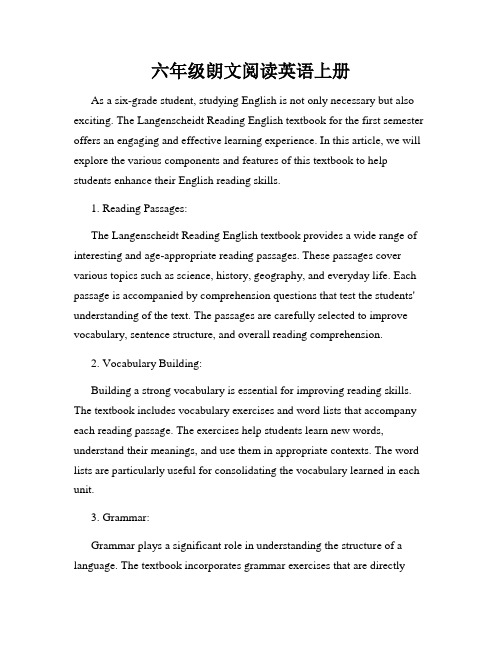
六年级朗文阅读英语上册As a six-grade student, studying English is not only necessary but also exciting. The Langenscheidt Reading English textbook for the first semester offers an engaging and effective learning experience. In this article, we will explore the various components and features of this textbook to help students enhance their English reading skills.1. Reading Passages:The Langenscheidt Reading English textbook provides a wide range of interesting and age-appropriate reading passages. These passages cover various topics such as science, history, geography, and everyday life. Each passage is accompanied by comprehension questions that test the students' understanding of the text. The passages are carefully selected to improve vocabulary, sentence structure, and overall reading comprehension.2. Vocabulary Building:Building a strong vocabulary is essential for improving reading skills. The textbook includes vocabulary exercises and word lists that accompany each reading passage. The exercises help students learn new words, understand their meanings, and use them in appropriate contexts. The word lists are particularly useful for consolidating the vocabulary learned in each unit.3. Grammar:Grammar plays a significant role in understanding the structure of a language. The textbook incorporates grammar exercises that are directlyrelated to the reading passages. By analyzing and practicing grammar in context, students can deepen their understanding of English grammar rules. The clear explanations and examples provided in the textbook make it easier for students to grasp complex grammatical concepts.4. Comprehension and Inference:Comprehension and inference are crucial skills when it comes to reading. The Langenscheidt Reading English textbook includes activities that require students to identify the main idea, make inferences, draw conclusions, and summarize the information from the reading passages. These activities promote critical thinking, improve reading comprehension, and encourage students to think beyond the text.5. Extended Activities:To encourage a more in-depth understanding of the reading passages, the textbook offers extended activities. These activities may include group discussions, creative writing exercises, and real-life application tasks. The extended activities not only enhance reading skills but also boost creativity, teamwork, and critical thinking abilities.6. Progress Monitoring:Regular assessment is vital to gauge students' progress. The textbook provides unit tests, quizzes, and progress check activities to evaluate comprehension and retention. These assessments help both students and teachers identify areas of improvement and ensure effective learning.In conclusion, the Langenscheidt Reading English textbook for the first semester of six-grade provides a comprehensive and engaging learningexperience. With its carefully chosen reading passages, vocabulary exercises, grammar activities, and comprehension tasks, this textbook promotes effective language acquisition and enhances students' reading abilities. By using this textbook, students can strengthen their English skills and develop a lifelong love for reading.。
深圳朗文版六年级上册unit 1
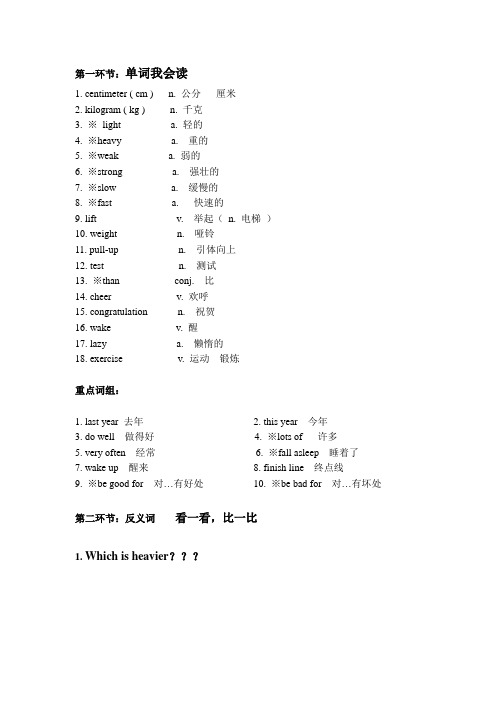
第一环节:单词我会读1. centimeter ( cm ) n. 公分厘米2. kilogram ( kg ) n. 千克3. ※light a. 轻的4. ※heavy a. 重的5. ※weak a. 弱的6. ※strong a. 强壮的7. ※slow a. 缓慢的8. ※fast a. 快速的9. lift v. 举起(n. 电梯)10. weight n. 哑铃11. pull-up n. 引体向上12. test n. 测试13. ※than conj. 比14. cheer v. 欢呼15. congratulation n. 祝贺16. wake v. 醒17. lazy a. 懒惰的18. exercise v. 运动锻炼重点词组:1. last year 去年2. this year 今年3. do well 做得好4. ※lots of 许多5. very often 经常6. ※fall asleep 睡着了7. wake up 醒来8. finish line 终点线9. ※be good for 对…有好处10. ※be bad for 对…有坏处第二环节:反义词看一看,比一比1. Which is heavier???a kilo of iron 2 kilo of cotton →轻的重的2. Who is faster???The Tortoise and the Hare→快的慢的3. Who is stronger?Tim and Bob→强壮的弱的仿照例子写出下列形容词的比较级(1)tall—tallerLight________short_________ fast_________ weak___________ (2) large ---largerNice________ late__________ wide_________(3) heavy—heavierEarly_______ happy_________ lazy________(4) big—biggerthin________ fat___________ wet_________ hot__________ 让我们一起来总结所学的内容吧!形容词的反义词:1.big---small2. heavy---light3. slow---fast4. dirty---clean5. beautiful---ugly6. fat---thin7. long---short 8. tall---short 9. hot---cold10. different---same 11. weak---strong 12. fun---boring形容词的比较级1. 一般情况在原级词尾后+ertall---taller short---shorter light---lighterlong---longer strong---stronger weak---weakerslow---slower fast---faster small---smaller1.以e结尾的词,直接+ernice---nicer large---larger3. 以辅音字母+y结尾的词,应先改y为i 后+erheavy---heavier happy---happier lazy---laziereasy---easier noisy---noisier early---earlier4.以重读闭音节且只有一个辅音字母结尾的词,应双写这个辅音字母后+erbig---bigger fat---fatter thin---thinnerhot---hotter wet---wetter red---redder第三环节:简单句型读一读look at 看着什么朝着什么看like to do sth 喜欢做什么What happened (to sb)?(某人)发生了什么?What’s wrong with (sb/sth)?(某人/物)发生了什么?fall asleep 熟睡睡着wake up 醒来叫醒get to/arrive in 到达be afraid of 害怕too much +不可数名词too many+可数名词复数第四环节:随堂检测1. 改写句子,使意思相同(1) Pat is lighter than Candy.Candy is ________ _________ Pat.(2) Tim is stronger than last year.Tim is stronger_______ _______.(3) John and Peter are slower than Tim.Tim is _______ _______ John and Peter.二. 选出最佳选项完成句子。
六年级上册英语各单元知识点总结

一、课文1. 介绍主要课文内容和故事情节2. 分析课文中的语法结构和词汇3. 总结课文中的重要句型和常用表达二、语法1. 介绍本学期所学的语法知识2. 分析每个语法知识点的用法和特点3. 给出一些例句和练习题进行巩固三、词汇1. 积累本学期所学的核心词汇2. 给出一些词汇相关的拓展练习3. 讲解一些词汇的词义辨析和常见搭配四、听力1. 介绍本学期所学的听力内容2. 提供一些听力练习题目和听力技巧3. 给出一些实用的听力训练方法五、口语1. 总结本学期所学的口语表达2. 分析口语中常见的错误和纠正方法3. 给出一些口语练习的建议和技巧六、阅读1. 提炼本学期所学的阅读材料2. 给出一些阅读理解题目和解题技巧3. 分析阅读材料中的重点句子和词汇七、写作1. 总结本学期所学的写作技巧2. 给出一些写作练习题目和范文3. 讲解写作中常见错误和改正方法八、课外拓展1. 推荐一些适合学生阅读的英语故事书2. 提供一些英语学习全球信息站或APP推荐3. 总结学期末考试的复习建议和注意事项以上是六年级上册英语各单元知识点总结的内容大纲,希望能够帮助学生系统地复习所学知识,提高英语学习成绩。
一、课文2. 分析课文中的语法结构和词汇在六年级上册的英语课本中,课文中的语法结构和词汇包括了一些基本的句型和词汇表达。
在描述一个人物时,我们可以使用“he is…”或者“she has…”来介绍他们的外貌特征和个性特点;在叙述一个事件或者故事情节时,我们可以使用一般过去时的句型,比如“Last week, I went to the zoo”等等。
在课文中也会包括一些常用的高频单词和短语,比如一些常见的动词、名词、形容词等,比如“play, eat, happy, sad, home, school”等等。
这些语法结构和词汇的掌握对于学生的语言运用和表达能力具有重要意义。
3. 总结课文中的重要句型和常用表达在六年级上册的英语课本中,课文中会涉及一些重要的句型和常用表达。
六年级上册前五单元英语知识点整理[共5篇]
![六年级上册前五单元英语知识点整理[共5篇]](https://img.taocdn.com/s3/m/54b9310359fb770bf78a6529647d27284a73374e.png)
六年级上册前五单元英语知识点整理[共5篇]第一篇:六年级上册前五单元英语知识点整理Unit 1 1.音标:⑴ 元音:[ɑ:]、[ɜ:]、[ i:]、[ɔ:]、[u:]、[ʌ]、[ɪ]、[ɒ]、[ʊ]、[ə]、[e]、[æ]、[ei]、[ai]、[ɔi]、[iə]、[ɛə]、[uə]、[au]、[əu]⑵ 辅音:[p]、[b]、[t]、[d]、[k]、[g]、[f]、[v]、[s]、[z]、[θ]、[ð]、[ʃ]、[ʒ]、[tʃ]、[dʒ]、[tr]、[dr]、[ts]、[dz]、[m]、[n]、[ŋ]、[h]、[l]、[r]、[j]、[w] ⑶ 5个元音字母:a、e、i、o、u 2.打招呼用语:⑴ Good morning!-----Good morning!Good afternoon!-----Good afternoon!Good evening!-------Good evening!⑵ How are you?-------I'm fine, thank you./I'm OK, thanks.How is she?------She's fine.⑶Nice to meet you.-------Nice to meet you, too.⑷Your bike is so beautiful.------Thank you.3.缩略语:课本P95。
4.男女孩名字区分:课本P109。
5.be动词(是)用法:⑴ am:跟在I后面。
⑵ is:跟在单数后面,如:he、she、it、单个人或物。
⑶ are:跟在复数和you后面,如:they,两个或两个以上人或物。
1.重点句型:⑴ What is this in English?---------It's a jacket./It's an apple.⑵ Spell it, please.= Please spell it.= How do you spell it?-------P-E-N.2.不定冠词a/an 用法:a 和 an 均用在单数名词之前,表示一类人或事物中的“一个”,相当于汉语中的“一”,但不强调数目概念。
六年级上册1~6单元英语笔记
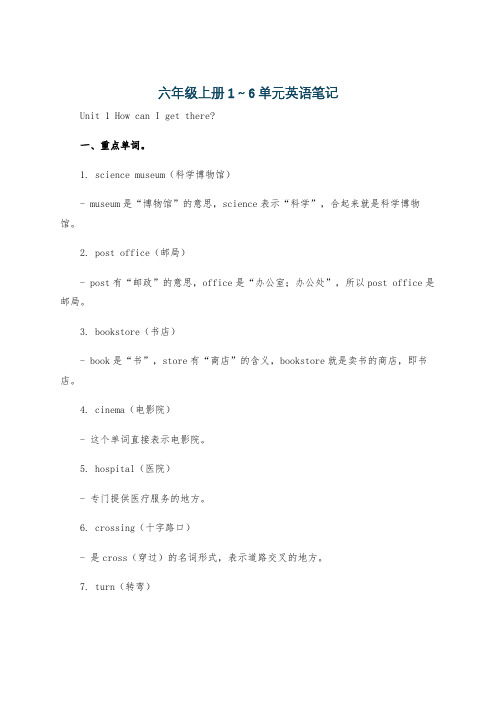
六年级上册1~6单元英语笔记Unit 1 How can I get there?一、重点单词。
1. science museum(科学博物馆)- museum是“博物馆”的意思,science表示“科学”,合起来就是科学博物馆。
2. post office(邮局)- post有“邮政”的意思,office是“办公室;办公处”,所以post office是邮局。
3. bookstore(书店)- book是“书”,store有“商店”的含义,bookstore就是卖书的商店,即书店。
4. cinema(电影院)- 这个单词直接表示电影院。
5. hospital(医院)- 专门提供医疗服务的地方。
6. crossing(十字路口)- 是cross(穿过)的名词形式,表示道路交叉的地方。
7. turn(转弯)- 既可以作动词,如turn left(向左转),turn right(向右转);也可以作名词。
二、重点短语。
1. near(在……附近)- 例如:The post office is near the bookstore.(邮局在书店附近。
)2. next to(紧挨着;与……相邻)- My home is next to the cinema.(我的家紧挨着电影院。
)3. in front of(在……前面)- There is a tree in front of my house.(我家前面有一棵树。
注意:in front of是在物体外部的前面,而in the front of是在物体内部的前面,如There is a blackboard in the front of the classroom.教室里前面有一块黑板。
)4. behind(在……后面)- The cat is behind the box.(猫在盒子后面。
)5. go straight(直走)- Go straight and you can see the hospital.(直走你就能看到医院。
六年级上册英语课件Unit 4 Revision_深港朗文版
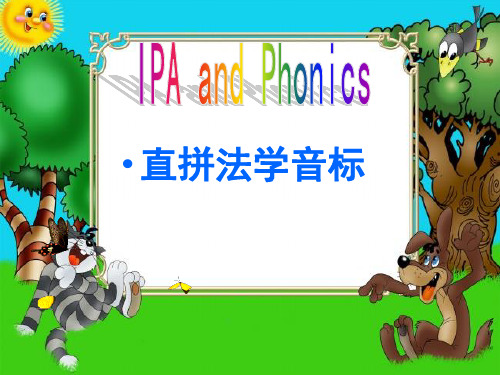
IPA and Phonics 音标与直拼法
1 Voiceless or voiced consonants
(分辨清辅音和浊辅音)
p p p /p/ /p/ / p /
清辅音:气流冲出,声带不震动
b b b /b/ /b/ / b /
浊辅音:不送气,声带震动比较大。 。
Read the IPA and mark
Task1 :爱“拼”才会赢
3-2
结合以前学过的元音发音规律,直接读出下列生词
Task2 :爱“拼”才会赢
3-2
Task3 :爱“拼”才会赢
3-2
推荐
Reading __a bridge to the world 阅 读 ___ 通往世界的桥梁
[Ѳ] --three--thick th
[ð]-- this -- there
[ʧ] -chair-watch
[ k] ache-character
ch
[∫] machine_chef
[dӡ ]sandwich Greenwich
j –jeep -just [dӡ ] gy- gym -biology
• You have to believe in yourself. That's the secret of success. 人必须相信自己,这是成功的秘诀。
•
[ t ] or [ d ]
• worked helped washed watched • called learned lived listened
13、He who seize the right moment, is the right man.谁把握机遇,谁就心想事成。2021/8/252021/8/252021/8/252021/8/258/25/2021 •14、谁要是自己还没有发展培养和教育好,他就不能发展培养和教育别人。2021年8月25日星期三2021/8/252021/8/252021/8/25 •15、一年之计,莫如树谷;十年之计,莫如树木;终身之计,莫如树人。2021年8月2021/8/252021/8/252021/8/258/25/2021 •16、教学的目的是培养学生自己学习,自己研究,用自己的头脑来想,用自己的眼睛看,用自己的手来做这种精神。2021/8/252021/8/25August 25, 2021 •17、儿童是中心,教育的措施便围绕他们而组织起来。2021/8/252021/8/252021/8/252021/8/25
六年级英语上册知识点总结及重难点解析
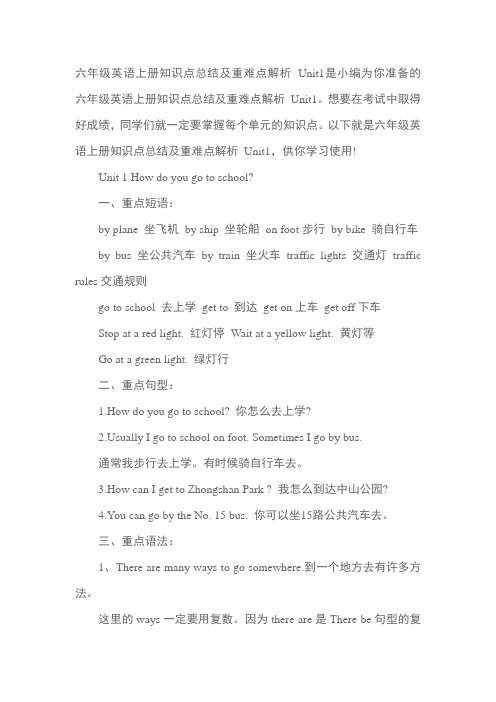
六年级英语上册知识点总结及重难点解析Unit1是小编为你准备的六年级英语上册知识点总结及重难点解析Unit1。
想要在考试中取得好成绩,同学们就一定要掌握每个单元的知识点。
以下就是六年级英语上册知识点总结及重难点解析Unit1,供你学习使用!Unit 1 How do you go to school?一、重点短语:by plane 坐飞机by ship 坐轮船on foot步行by bike 骑自行车by bus 坐公共汽车by train 坐火车traffic lights 交通灯traffic rules交通规则go to school 去上学get to 到达get on上车get off下车Stop at a red light. 红灯停Wait at a yellow light. 黄灯等Go at a green light. 绿灯行二、重点句型:1.How do you go to school? 你怎么去上学?ually I go to school on foot. Sometimes I go by bus.通常我步行去上学。
有时候骑自行车去。
3.How can I get to Zhongshan Park ? 我怎么到达中山公园?4.You can go by the No. 15 bus. 你可以坐15路公共汽车去。
三、重点语法:1、There are many ways to go somewhere.到一个地方去有许多方法。
这里的ways一定要用复数。
因为there are是There be句型的复数形式。
2、on foot 步行乘坐其他交通工具大都可以用介词by…,但是步行只能用介词on 。
4、go to school的前面绝对不能加the,这里是固定搭配。
5、USA 和US 都是美国的意思。
另外America也是美国的意思。
6、go to the park 前面一定要加the. 如果要去的地方有具体的名字,就不能再加the ,如果要去的地方没有具体名字,都要在前面加the. ( go to school除外。
六年级上册英语单元知识点总结
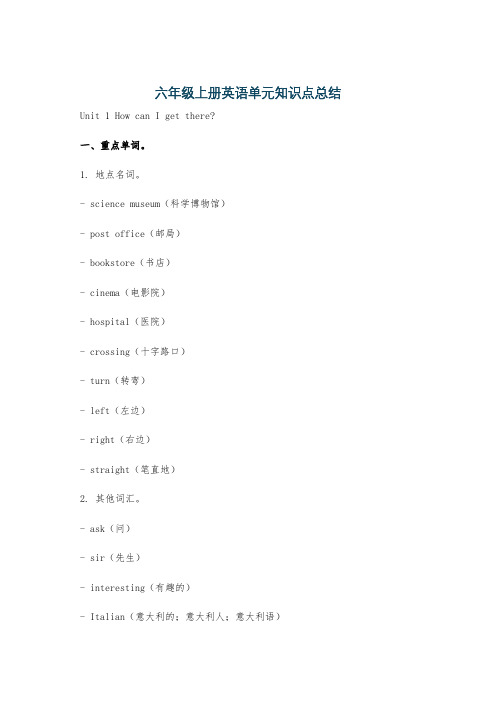
六年级上册英语单元知识点总结Unit 1 How can I get there?一、重点单词。
1. 地点名词。
- science museum(科学博物馆)- post office(邮局)- bookstore(书店)- cinema(电影院)- hospital(医院)- crossing(十字路口)- turn(转弯)- left(左边)- right(右边)- straight(笔直地)2. 其他词汇。
- ask(问)- sir(先生)- interesting(有趣的)- Italian(意大利的;意大利人;意大利语)- restaurant(餐馆)- pizza(比萨饼)- street(大街;街道)- get(到达)- GPS(全球定位系统)- gave(give的过去式,提供;交给)- feature(特点)- follow(跟着)- far(远的)- tell(告诉)二、重点短语。
1. 问路相关。
- turn left(向左转)- turn right(向右转)- go straight(直走)- in front of(在……前面)- next to(紧挨着)- near(在……附近)- behind(在……后面)2. 到达某地的表达。
- get to(到达),例如:get to the park(到达公园)- arrive at(到达小地点,如:arrive at the cinema到达电影院)- arrive in(到达大地点,如:arrive in Beijing到达北京)三、重点句型。
1. 问路句型。
- Where is the + 地点? 例如:Where is the post office?(邮局在哪里?)- How can I get to the + 地点? 例如:How can I get to the bookstore?(我如何能到达书店?)2. 指路句型。
